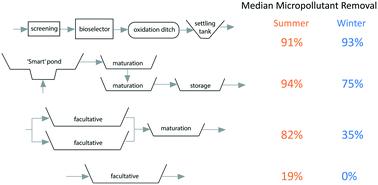当前位置:
X-MOL 学术
›
Environ. Sci.: Water Res. Technol.
›
论文详情
Our official English website, www.x-mol.net, welcomes your
feedback! (Note: you will need to create a separate account there.)
Chemical removal in waste stabilisation pond systems of varying configuration
Environmental Science: Water Research & Technology ( IF 3.5 ) Pub Date : 2021-07-08 , DOI: 10.1039/d1ew00129a Kathryn L. Linge 1, 2 , Deborah Liew 1 , Yolanta Gruchlik 1 , Francesco Busetti 1, 3 , Una Ryan 4 , Cynthia A. Joll 1
Environmental Science: Water Research & Technology ( IF 3.5 ) Pub Date : 2021-07-08 , DOI: 10.1039/d1ew00129a Kathryn L. Linge 1, 2 , Deborah Liew 1 , Yolanta Gruchlik 1 , Francesco Busetti 1, 3 , Una Ryan 4 , Cynthia A. Joll 1
Affiliation

|
While nutrient removal has been well studied in waste stabilisation ponds (WSPs), studies of organic micropollutant removal in pond systems are limited. In this study, we investigated organic micropollutant, nitrogen and organic carbon removal in selected WSPs that differed in geographical location and pond configuration, and compared their performance to an oxidation ditch wastewater treatment plant (WWTP). Of the 232 chemicals measured, 36 were detected in wastewater influent and 33 were detected in treated wastewater effluent. New data for micropollutant removal in WSPs was generated for three pesticides or related chemicals, five pharmaceuticals, the plasticizer N-butylbenzenesulfonamide, the antioxidant 2,6-di-t-butyl-p-cresol, and two flame retardants tris(dichloropropyl)phosphate and tris(chloropropyl)phosphate isomers. Most of these micropollutants were relatively well removed in WSPs. The poorest treatment efficiency was observed in the single facultative pond system, with no maturation pond, suggesting that the presence of a maturation pond is important for chemical removal. The two WSPs in temperate climates were found to have higher concentrations of motile algae that can optimise their position with respect to light and temperature. However, to-date, the micropollutant removal by these algal species is not known. The highest removals of micropollutants in a WSP were measured in a complex WSP system with two maturation ponds, and the removals achieved were comparable to the oxidation ditch system. The key factors contributing to high micropollutant removal in this WSP were high solar irradiation and warm temperatures that promoted the growth of non-motile green algae previously found to degrade micropollutants, and photodegradation.
中文翻译:

不同配置的废物稳定池系统中的化学去除
虽然已经在废物稳定池 (WSP) 中对养分去除进行了很好的研究,但对池塘系统中有机微污染物去除的研究是有限的。在这项研究中,我们调查了地理位置和池塘配置不同的选定 WSP 中有机微污染物、氮和有机碳的去除,并将它们的性能与氧化沟废水处理厂 (WWTP) 进行了比较。在测量的 232 种化学物质中,36 种在废水进水中检测到,33 种在处理过的废水中检测到。三种杀虫剂或相关化学品,五种药物,增塑剂产生用于在微量污染物的WSP去除新数据Ñ -butylbenzenesulfonamide,所述抗氧化剂的2,6-二-吨丁基- p-甲酚和两种阻燃剂三(二氯丙基)磷酸酯和三(氯丙基)磷酸酯异构体。这些微污染物中的大部分在 WSP 中都得到了较好的去除。在没有成熟池的单一兼性池塘系统中观察到最差的处理效率,这表明成熟池的存在对于化学去除很重要。发现温带气候中的两个 WSP 具有更高浓度的活动藻类,可以优化它们在光和温度方面的位置。然而,迄今为止,这些藻类物种对微污染物的去除作用尚不清楚。在具有两个成熟池的复杂 WSP 系统中测量了 WSP 中微污染物的最高去除率,所达到的去除率与氧化沟系统相当。
更新日期:2021-07-13
中文翻译:

不同配置的废物稳定池系统中的化学去除
虽然已经在废物稳定池 (WSP) 中对养分去除进行了很好的研究,但对池塘系统中有机微污染物去除的研究是有限的。在这项研究中,我们调查了地理位置和池塘配置不同的选定 WSP 中有机微污染物、氮和有机碳的去除,并将它们的性能与氧化沟废水处理厂 (WWTP) 进行了比较。在测量的 232 种化学物质中,36 种在废水进水中检测到,33 种在处理过的废水中检测到。三种杀虫剂或相关化学品,五种药物,增塑剂产生用于在微量污染物的WSP去除新数据Ñ -butylbenzenesulfonamide,所述抗氧化剂的2,6-二-吨丁基- p-甲酚和两种阻燃剂三(二氯丙基)磷酸酯和三(氯丙基)磷酸酯异构体。这些微污染物中的大部分在 WSP 中都得到了较好的去除。在没有成熟池的单一兼性池塘系统中观察到最差的处理效率,这表明成熟池的存在对于化学去除很重要。发现温带气候中的两个 WSP 具有更高浓度的活动藻类,可以优化它们在光和温度方面的位置。然而,迄今为止,这些藻类物种对微污染物的去除作用尚不清楚。在具有两个成熟池的复杂 WSP 系统中测量了 WSP 中微污染物的最高去除率,所达到的去除率与氧化沟系统相当。











































 京公网安备 11010802027423号
京公网安备 11010802027423号